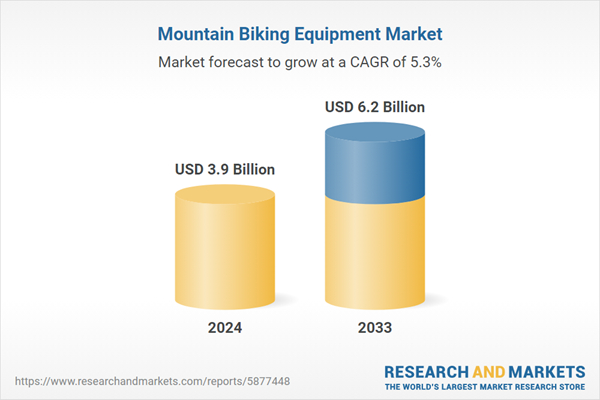Mountain biking equipment refers to the specialized gear and accessories used by riders to enhance their safety, comfort, and performance while engaging in off-road cycling activities. These are specifically designed to withstand the rugged terrains and challenges encountered during mountain biking adventures. Some most commonly used mountain biking equipment includes protective gear, bike components, bicycles, clothing, tools and repair kits, and other accessories, such as hydration packs, bike lights, GPS devices, bike racks, and bike locks. These items enhance comfort and the overall riding experience. They also aid in ensuring rider safety, maximizing performance, and enabling riders to navigate challenging trails and terrains. As a result, mountain biking equipment is widely used by individuals across the globe for a successful and enjoyable riding experience.
Mountain Biking Equipment Market Trends:
The escalating demand for high-quality biking gear and accessories represents one of the primary factors supporting the market growth. Moreover, the growing popularity of mountain biking as a recreational and sporting activity among people seeking outdoor adventures is leading to a surge in demand for mountain biking equipment. Additionally, due to a surging emphasis on rider safety, there is a growing demand for high-quality protective gear, including helmets, pads, body armor, and gloves that offer superior impact absorption, ventilation, and comfort. In line with this, the rising participation of women in mountain biking has accelerated the adoption of specialized equipment and gear designed specifically for female riders, such as women's bikes, clothing, and protective gear. Besides this, the increasing consumer preferences for eco-friendly and sustainable products, including bikes made from recycled materials and environmentally friendly manufacturing processes, are augmenting the market growth. Furthermore, the leading manufacturers are incorporating novel features, such as advanced suspension systems, lightweight materials, electronic shifting systems, and improved safety features to enhance performance and rider experience. Along with this, the rising collaborations among mountain biking equipment manufacturers and professional riders and heavy investments in team and event sponsorships for brand promotion, product testing, and gaining credibility among the target audience are propelling the market growth. Other factors, including the surging penetration of online retail channels, increasing safety consciousness, continual technological advancements, inflating consumer purchasing power, and evolving preferences and needs of mountain biking enthusiasts, are also anticipated to fuel the market growth.Key Market Segmentation:
The publisher provides an analysis of the key trends in each segment of the global mountain biking equipment market, along with forecasts at the global, regional, and country levels from 2025-2033. Our report has categorized the market based on product.Product Insights:
- Protective Gears
- Mountain Biking Tools
Regional Insights:
- North America
- United States
- Canada
- Asia-Pacific
- China
- Japan
- India
- South Korea
- Australia
- Indonesia
- Others
- Europe
- Germany
- France
- United Kingdom
- Italy
- Spain
- Russia
- Others
- Latin America
- Brazil
- Mexico
- Others
- Middle East and Africa
Competitive Landscape:
The report has also provided a comprehensive analysis of the competitive landscape in the global mountain biking equipment market. Detailed profiles of all major companies have been provided. Some of the companies covered include Endura Limited (Pentland Brands Limited), Giant Manufacturing Co. Ltd., Scott Sports SA (Youngone Corporation), Shimano Inc., Troy Lee Designs Inc., Vista Outdoor Inc., etc. Kindly note that this only represents a partial list of companies, and the complete list has been provided in the report.Key Questions Answered in This Report:
- How has the global mountain biking equipment market performed so far, and how will it perform in the coming years?
- What are the drivers, restraints, and opportunities in the global mountain biking equipment market?
- What is the impact of each driver, restraint, and opportunity on the global mountain biking equipment market?
- What are the key regional markets?
- Which countries represent the most attractive mountain biking equipment market?
- What is the breakup of the market based on the product?
- Which is the most attractive product in the mountain biking equipment market?
- What is the competitive structure of the global mountain biking equipment market?
- Who are the key players/companies in the global mountain biking equipment market?
Table of Contents
Companies Mentioned
- Endura Limited (Pentland Brands Limited)
- Giant Manufacturing Co. Ltd.
- Scott Sports SA (Youngone Corporation)
- Shimano Inc.
- Troy Lee Designs Inc.
- Vista Outdoor Inc.
Table Information
| Report Attribute | Details |
|---|---|
| No. of Pages | 139 |
| Published | March 2025 |
| Forecast Period | 2024 - 2033 |
| Estimated Market Value ( USD | $ 3.9 Billion |
| Forecasted Market Value ( USD | $ 6.2 Billion |
| Compound Annual Growth Rate | 5.3% |
| Regions Covered | Global |
| No. of Companies Mentioned | 6 |









